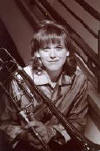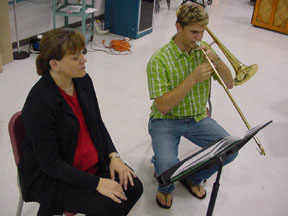| Tone
Production |
Concept of Sound
Breathing/Breath Support
Embouchure Formation
Combining Breathing and Breath Support and Embouchure
Mouthpiece Placement
Creating Sound
-
Before a student tries to play a sound on a horn, he/she should know what sound he/she is trying to make.
-
There is no substitute for a concept of sound; it is the most important aspect of tone production.
-
Perform and demonstrate often if at all possible!
-
Bring in clinicians, private lesson teachers
-
Play recordings:
-
Lindberg, Christian -- Bis 378 David, Grondahl, Guilmant
-
Conant, Abbie -- Audite 97410 Guilmant, Marcello, Handel
-
Bousfield, Ian -- Doyen 014 Blue Bells of Scotland
-
-
This is one of the most important aspects of performing on any brass instrument.
-
"Sustain the beautiful music from below the rib cage with no conscious muscle involvement on the intake or the blow." (Buddy Baker)
-
Student should sit gently tall (relaxed). The spine should be straight. ( Do not curve the lower back.)
-
Intake
-
Think the syllable "HAW" on the inhale.
-
Air should fill the lower abdominal muscles first (below the belt line) -- then to the middle -- finally to the upper chest.
-
There should be no gasping or wheezing sounds. Stay relaxed.
-
-
Exhale
-
Use the syllable "POO" (after the embouchure is set, use "TOO").
-
Support the sound. Use the air first from the lower abdominal muscles -- then the middle -- and finally the upper (if needed.)
-
The inhale and exhale should be one continuous smooth, relaxed motion.
-
There should be a visible movement of the lower abdomen during this process.
-
-
Use the student's natural lip formation, a natural "facial mask."
-
Bring the jaw forward slightly.
-
Upper lips and cheeks "gently hug" the teeth and gums so air can come through the center of the lips ONLY -- no air puffs. (Buddy Baker)
-
Flat chin.
-
I prefer a wet embouchure.
-
Teeth slightly apart.
-
Use "POO" so that the lips are slightly pursed.
-
Gently firm corners (not pulled back, i.e. smiling)
-
Most relaxed part of embouchure is the aperture (the center of the lips).
Combining Breathing and Breath Support and Embouchure
-
Use the syllable "TOO."
-
Hold a piece of paper in front of the air stream for a visual reinforcement.
-
Watch for "smiling", puffed cheeks, bad habits, etc.
-
Hold the mouthpiece by the shank with two fingers and a thumb.
-
The mouthpiece should be positioned with more of it on the upper lip than the lower.
-
The vertical placement is more important than the horizontal. (Some players perform off center because of dental structure.)
-
Practice placing the mouthpiece.
-
Start with the mouthpiece by itself. Place it gently on the embouchure and blow "TOO." Remember to constantly reinforce proper breath techniques and embouchure formation, constantly correcting bad habits.
-
Some may have trouble producing a sound; keep trying. It may help to partially cover the end of the shank with the "pinkie" to create more resistance.
| If you would like to be added to the TSMP Email Mailing List and receive periodic notifications of new articles and updates to this website, then please email TSMP.
The Texas School Music
Project is a source for ideas and information
concerning pedagogical
practices in the music classroom or rehearsal hall. The TSMP is a service provided to
all music specialists by the faculty
of
the Department of Music
at Stephen F. Austin State University. Copyright ? 2002, Department of Music at Stephen F. Austin State University |

